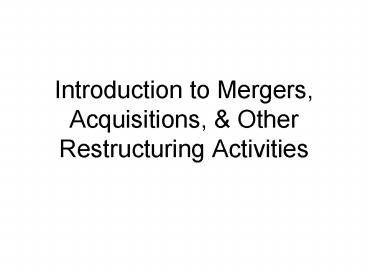Introduction to Mergers, Acquisitions, - PowerPoint PPT Presentation
1 / 17
Title:
Introduction to Mergers, Acquisitions,
Description:
Ego/Hubris. Tax considerations. Empirical Findings ... Hubris. Common reasons M&As fail to meet expectations. Overpayment due to overestimating synergy ... – PowerPoint PPT presentation
Number of Views:44
Avg rating:3.0/5.0
Title: Introduction to Mergers, Acquisitions,
1
Introduction to Mergers, Acquisitions, Other
Restructuring Activities
2
Course Layout
3
Course Learning Objectives
- Define what corporate restructuring is and why it
occurs - Identify commonly used valuation techniques
- Describe how corporate restructuring
creates/destroys value - Identify commonly used takeover tactics and
defenses - Develop a highly practical planning based
approach to managing the MA process - Identify challenges and solutions associated with
each phase of the MA process - Describe advantages and disadvantages of
alternative MA deal structures - Describe how to plan, structure, and manage JVs,
partnerships, alliances, licensing arrangements,
equity partnerships, franchises, and minority
investments
4
Current Chapter Learning Objectives
- Primary objective What corporate restructuring
is and why it occurs - Secondary objective Provide students with an
understanding of - Commonly used MA vocabulary
- MA as only one of a number of strategic options
for increasing shareholder value - MA activity in an historical context
- The primary motivations for MA activity
- Key empirical findings
5
Alternative Forms of Corporate Restructuring
- Restructuring Activity
- Corporate Restructuring
- Balance Sheet
- Assets Only
- Financial Restructuring (liabilities only)
- Operational Restructuring
- Potential Strategy
- Redeploy Assets
- Mergers, Break-Ups, Spin-Offs
- Acquisitions, divestitures, etc.
- Increase leverage to lower cost of capital or as
a takeover defense - Divestitures, widespread employee reduction, or
reorganization
6
Building a Common Vocabulary
- Combination of 2 firms with only one surviving
- Target becomes a subsidiary of the parent
- Two or more firms merge to form a new company
- Purchase of a target firm, controlling interest,
or specific target assets - Buyout financed primarily by debt
- One firm with investments in a number of
operating companies
- Statutory Merger
- Subsidiary Merger
- Consolidation
- Acquisition
- Leveraged Buyout
- Holding Company
7
Alternative Ways of Increasing Shareholder Value
- Solo venture (AKA going it alone or organic
growth) - Partnering (Marketing/distribution alliances,
JVs, licensing, franchising, and equity
investments) - Mergers and acquisitions
- Minority investments in other firms
- Asset swaps
- Financial restructuring
- Operational restructuring
8
Merger Waves
- Horizontal Consolidation (1897-1904)
- Increasing Concentration (1916-1929)
- The Conglomerate Era (1965-1969)
- The Retrenchment Era (1981-1989)
- Age of the Strategic Megamerger (1992-2000)
9
Horizontal Consolidation (1897-1904)
- Spurred by
- Drive for efficiency,
- Lax enforcement of antitrust laws
- Westward migration, and
- Technological change
- Resulted in concentration in metals,
transportation, and mining industry - MA boom ended by 1904 stock market crash and
fraudulent financing
10
Increasing Concentration (1916-1929)
- Spurred by
- Entry of U.S. into WWI
- Post-war boom
- Boom ended with
- 1929 stock market crash
- Passage of Clayton Act which more clearly defined
monopolistic practices
11
The Conglomerate Era (1965-1969)
- Conglomerates employ financial engineering to
boost their share price - High P/E firms acquired lower P/E target firms
- Combined firms share price increased if
investors applied the higher P/E to the combined
firms EPS - Number of high-growth, low P/E firms declined as
conglomerates bid up their prices - Higher purchase price for target firms and
increasing leverage of conglomerates brought era
to a close
12
The Retrenchment Era (1981-1989)
- Strategic U.S. buyers and foreign multinationals
dominated first half of decade - Second half dominated by financial buyers
- Buyouts often financed by junk bonds
- Drexel Burnham provided market liquidity
- Era ended with bankruptcy of several large LBOs
and demise of Drexel Burnham
13
Age of the Strategic Megamerger (1992-2000)
- Dollar volume of transactions reached record in
each year between 1995 and 2000 - Purchase prices reached record levels due to
- Soaring stock market
- Consolidation in many industries
- Technological innovation
- Benign antitrust policies
- Period ended with the collapse in global stock
markets and worldwide recession
14
Motivations for MA
- Strategic realignment
- Technological change
- Deregulation
- Synergy
- Economies of scale/scope
- Cross-selling
- Diversification (Related/Unrelated)
- Financial considerations
- Acquirer believes target is undervalued
- Booming stock market
- Falling interest rates
- Market power
- Ego/Hubris
- Tax considerations
15
Empirical Findings
- Around transaction announcement date, abnormal
returns average - 20 for target shareholders in friendly
transactions 30-35 in hostile transactions - Bidders shareholders earn 2-3
- 50-80 of MAs fail to outperform their industry
peers or earn their cost of capital during the
3-5 years following closing - No evidence that alternative strategies to MAs
are likely to be more successful
16
Primary Reasons for MAs Frequent Failure to Meet
Expectations
- Overpayment due to over-estimating synergy
- Slow pace of integration
- Poor strategy
17
Things to Remember
- Motivations for acquisitions
- Strategic realignment
- Synergy
- Diversification
- Financial considerations
- Hubris
- Common reasons MAs fail to meet expectations
- Overpayment due to overestimating synergy
- Slow pace of integration
- Poor strategy
- MAs typically reward target shareholders far
more than bidder shareholders - Success rate of MA not significantly different
from alternative ways of increasing shareholder
value





![get [PDF] Download Make the Deal: Negotiating Mergers and Acquisitions (Bloomberg Financial) (PDF) PowerPoint PPT Presentation](https://s3.amazonaws.com/images.powershow.com/10105739.th0.jpg?_=20240823021)


![Weekly Startup Funding and Acquisitions Report [24 – 29 Jun] PowerPoint PPT Presentation](https://s3.amazonaws.com/images.powershow.com/10070835.th0.jpg?_=20240703032)






















